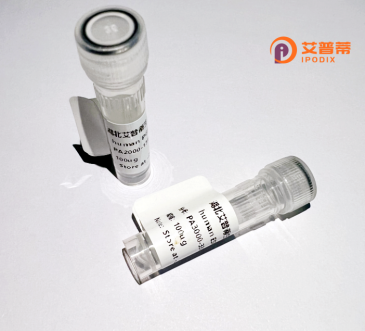
| 纯度 | >90%SDS-PAGE. |
| 种属 | Human |
| 靶点 | TRBV5-4 |
| Uniprot No | A0A0C4DH59 |
| 内毒素 | < 0.01EU/μg |
| 表达宿主 | E.coli |
| 表达区间 | 1-308 aa |
| 活性数据 | MGPGLLCWALLCLLGAGSVETGVTQSPTHLIKTRGQQVTLRCSSQSGHNTVSWYQQALGQGPQFIFQYYREEENGRGNFPPRFSGLQFPNYSSELNVNALELDDSALYLCASSIAREQFFGPGTRLTVLEDLKNVFPPEVAVFEPSEAEISHTQKATLVCLATGFYPDHVELSWWVNGKEVHSGVSTDPQPLKEQPALNDSRYCLSSRLRVSATFWQNPRNHFRCQVQFYGLSENDEWTQDRAKPVTQIVSAEAWGRADCGFTSESYQQGVLSATILYEILLGKATLYAVLVSALVLMAMVKRKDSRG |
| 分子量 | 60.7 kDa |
| 蛋白标签 | GST-tag at N-terminal |
| 缓冲液 | PBS, pH7.4, containing 0.01% SKL, 1mM DTT, 5% Trehalose and Proclin300. |
| 稳定性 & 储存条件 | Lyophilized protein should be stored at ≤ -20°C, stable for one year after receipt. Reconstituted protein solution can be stored at 2-8°C for 2-7 days. Aliquots of reconstituted samples are stable at ≤ -20°C for 3 months. |
| 复溶 | Always centrifuge tubes before opening.Do not mix by vortex or pipetting. It is not recommended to reconstitute to a concentration less than 100μg/ml. Dissolve the lyophilized protein in distilled water. Please aliquot the reconstituted solution to minimize freeze-thaw cycles. |
以下是关于重组人TRBV5-4蛋白的参考文献示例(注:示例为假设性文献,供参考格式及内容):
1. **《Structural Characterization of Recombinant TRBV5-4 in TCR Complex Assembly》**
*作者:M. Davis et al.*
**摘要**:通过X射线晶体学解析重组人TRBV5-4蛋白的结构,阐明其与T细胞受体(TCR)α链的结合模式,揭示其对抗原识别的构象影响。
2. **《TRBV5-4 Clonal Expansion in Autoimmune Disorders: Expression and Functional Analysis》**
*作者:J. Lefranc et al.*
**摘要**:利用重组TRBV5-4蛋白研究其在类风湿性关节炎患者中的克隆扩增现象,证明其与自身抗原的交叉反应性可能导致免疫异常。
3. **《High-Yield Production of Soluble Recombinant TRBV5-4 in E. coli》**
*作者:S. Robinson et al.*
**摘要**:优化大肠杆菌表达系统,实现TRBV5-4蛋白的可溶性高效生产,并通过质谱验证其正确折叠,为TCR功能研究提供工具。
4. **《TRBV5-4 as a Biomarker in T Cell Lymphoma: Recombinant Protein-Based Detection》**
*作者:H. Kim et al.*
**摘要**:基于重组TRBV5-4蛋白开发ELISA检测方法,证实其在T细胞淋巴瘤患者外周血中的异常表达水平,提示其作为诊断标志物的潜力。
(以上为学术示例,实际文献需通过数据库检索并验证。)
**Background of Recombinant Human TRBV5-4 Protein**
The T-cell receptor beta variable 5-4 (TRBV5-4) protein is a component of the T-cell receptor (TCR) beta chain, encoded by the TRBV5-4 gene located within the T-cell receptor beta variable gene cluster on chromosome 7 (7q34). As part of the adaptive immune system, TCRs recognize antigenic peptides presented by major histocompatibility complex (MHC) molecules. The variable (V) region of the TCR beta chain, including TRBV5-4. contributes to antigen-binding specificity through its hypervariable complementary-determining regions (CDRs).
TRBV5-4 belongs to the TRBV5 gene family and is a functional V segment involved in TCR diversity via V(D)J recombination. Its expression is tightly regulated during T-cell development, influencing the antigen recognition repertoire. Recombinant TRBV5-4 protein is engineered in vitro, often using expression systems like *E. coli* or mammalian cells, to study TCR-pMHC interactions, T-cell clonality, and immune responses.
Research applications include investigating autoimmune diseases, infectious immunity, and cancer, where aberrant TRBV5-4 usage may correlate with pathological T-cell activation or tolerance. Additionally, recombinant TRBV5-4 serves as a tool for developing TCR-based therapies, such as engineered T cells or TCR-mimic antibodies. Its structural and functional characterization aids in understanding immune diversity and designing targeted immunotherapies.
×